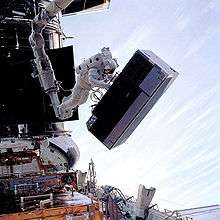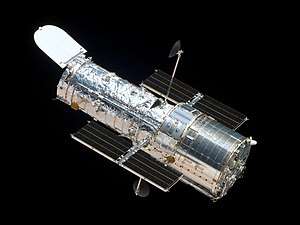Goddard High Resolution Spectrograph
The Goddard High Resolution Spectrograph (GHRS or HRS) was an ultraviolet spectrograph installed on the Hubble Space Telescope during its original construction, and it was launched into space as part of that space telescope aboard the Space Shuttle Discovery on April 24, 1990 (STS-31).[1] The instrument is named after 20th century rocket pioneer Robert H. Goddard.[2]


One of the results was the discovery of tenuous atmosphere for Jupiter's moon Europa in 1995.[3] The gas was determined to be mostly of molecular oxygen (O2).[3][4] The surface pressure of Europa's atmosphere is 0.1 μPa, or 10−12 times that of the Earth.[5]
An example GHRS use was to observe the local interstellar medium in the direction towards Capella.[6]
The Goddard High Resolution Spectrograph was removed from the Hubble Space Telescope during the February, 1997, Space Shuttle Discovery mission STS-82 (also called SM-2 for Servicing Mission 2). It, and the Faint Object Spectrograph,[7] were replaced by two new instruments installed during the mission,[8] the Near Infrared Camera and Multi-Object Spectrometer (NICMOS) and the Space Telescope Imaging Spectrograph.[9] [7]
Goddard High Resolution Spectrograph HRS facts
- Instrument type: Ultraviolet spectrograph
- Wavelength range: 1050 to 3200 Å (105 to 320 nm)
- Resolving Power
- Low - 2,000
- Medium - 25,000
- High - 80,000
A technical description of the construction and operation of the GHRS can be found in the GHRS instrument handbook. [10]
References
- "1992ASPC...33..243B Page 243". adsabs.harvard.edu. Retrieved 2017-03-02.
- "About the Telescope". Live from the Hubble Space Telescope. Passport to Knowledge. Retrieved 2017-02-22.
- Hall, D. T.; Strobel, D. F.; Feldman, P. D.; McGrath, M. A.; Weaver, H. A. (1995). "Detection of an oxygen atmosphere on Jupiter's moon Europa". Nature. 373 (6516): 677–681. Bibcode:1995Natur.373..677H. doi:10.1038/373677a0. PMID 7854447.
- Savage, Donald; Jones, Tammy; Villard, Ray (23 February 1995). "Hubble Finds Oxygen Atmosphere on Europa". Project Galileo. NASA, Jet Propulsion Laboratory. Retrieved 17 August 2007.
- McGrath (2009). "Atmosphere of Europa". In Pappalardo, Robert T.; McKinnon, William B.; Khurana, Krishan K. (eds.). Europa. University of Arizona Press. ISBN 0-8165-2844-6.
- "1993ApJ...402..694L Page 694". adsabs.harvard.edu. Retrieved 2017-03-02.
- "Hubble instruments". sci.esa.int. Retrieved 2017-03-02.
- "STS-125: Eight hour EVA-4 works STIS repair – Atlantis' TPS overview | NASASpaceFlight.com". www.nasaspaceflight.com. Retrieved 2017-03-02.
- SM3A
- "GHRS Handbook" (PDF).

